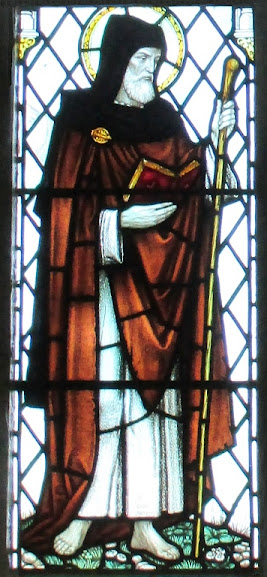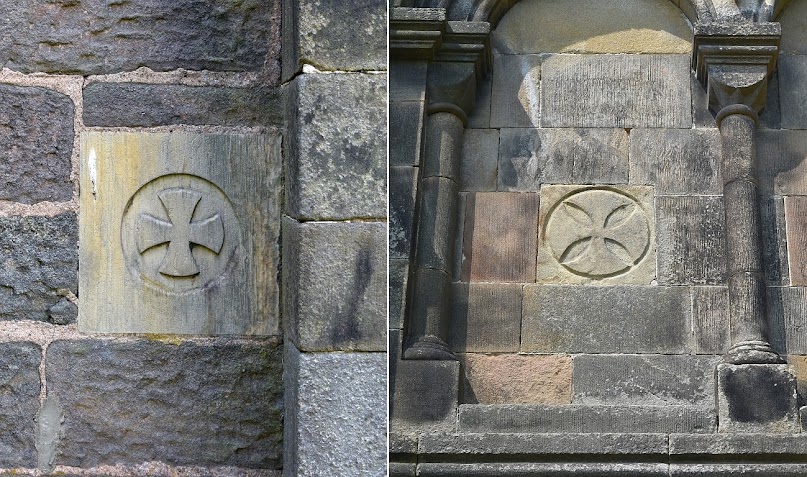Crosper is located three miles to the south east of Harrogate.
The Crosper place name survives today as Crosper Farm, on the road between Harrogate and the village of Spofforth. Crosper is thought to mean 'cross hill', perhaps from a cross having stood there in the past, although no cross exists today. In the fields around Crosper farm there are several large rock outcrops - part of the nearby Plumpton rocks group, which are thought to be the source of the Devil's Arrows standing stones at Boroughbridge, nine miles to the north. One of these outcrops on the east side of the farm is known as the Hell Hole rock, probably from the large cavity passing through one side of it.
Harry Speight provides a description of the site in his Nidderdale book
(Speight 1894) ...
The Ordnance Surveyors in the 1840's must have been told the local folklore connected with this outcrop, as they marked it on the first edition map as a "Supposed Druidical Rock". The only hint of folklore that this writer has come across was many years ago in the library of the Yorkshire Archaeological Society in Leeds. This was in an old guide book to the Harrogate area (printed in the late 1800's), which briefly mentioned the Hell Hole rock, along with the quote ...
"The undignified proceedings which often took place here within living memory are now consigned to the past."

|
|
The basin inside the cavity |
This intriguing sentence hints at the Hell Hole rock being the site of some activities that were frowned upon by the local establishment, but unfortunately the details were not recorded. Following the folklore traditions connected with other holed stones, it seems likely that the "undignified proceedings" involved people clambering through the hole in the rock, or something involving the large rock basin inside. This kind of activity at the Hell Hole, may have been why Harry Speight compared the site with the holed rock at Ponden Kirk. The Ponden Kirk outcrop has a tradition that anyone climbing through the hole would be married within the year. A more sinister version has it that any couple who crawled through the hole together must marry within the year or they would die. As with many unusual rock features, the Ponden Kirk seems to have also been linked with the fairy folk. At other locations, people crawled through holes and crevices in rocks hoping to be healed of various ailments, or for fertility reasons. (See the Wishing Stone at Glaisdale).
Writing in the early 1800's, Ely Hargrove refers to the location of the outcrop as the Hell Hole, while other writers point to the rock itself as the Hell Hole. The cavity in the outcrop is the most striking feature at this location so it would seem to be the likely source of the name. It has been suggested that the 'Hell' part of Hell Hole is derived from helli or halig, meaning holy. In this part of Yorkshire, holy wells were called Helliwells, while the Warholes well at nearby Kirby Overblow was recorded as War-helly-well in 1576. If this was the original meaning, then the Hell Hole (Holy Hole) name might point to an older tradition at the site.

|
|
Ely Hargrove's illustration (1798) |
The suggestion that a cross once stood at Crosper, with the 'Holy Hole' rock in a field nearby, and then across the fields to the east there is a Saint Helen's holy well (helli well?) might just hint at some pre-Reformation pilgrimage activity in the area. In Ireland there are examples of pilgrimage landscapes where people still perform religious devotions in a 'pattern', walking between the sites associated with a local saint. At Ardmore in Waterford people visit Saint Declan's grave, his holy well, and crawl through a gap beneath a large boulder known as Saint Declan's Stone.
During the Medieval period, the cult of Saint Robert attracted huge numbers of people to Knaresborough - only two miles to the north of Crosper. Saint Robert was associated with several sites in and around Knaresborough, and the pilgrims came to pray at his tomb, his chapel, his cave, and his holy well, all located alongside the river Nidd. Saint Robert also lived for a time as a hermit in the chapel of Saint Hilda at Rudfarlington (between Knaresborough and Crosper), but thieves forced him to leave, and so he found shelter in the village of Spofforth, half mile to the south of Crosper. The Hell Hole rock is located on the route mid way between St Hilda's chapel and Spofforth village. At that time much of the land in this area was held by the Knights Templar, who owned the manor of Ribston, and had a Preceptory there. The town of Wetherby (part of Spofforth parish) was also given to them, and there was some Templar link with the church at Spofforth. So this area may have been a safe haven for the saint.

|
| Saint Robert |
In later years, people from all over the country came on
pilgrimage to visit the sites associated with Saint Robert. Those travelling
from the south would leave the Old North Road at Wetherby, and then pass
through either Ribston or Spofforth to reach Knaresborough. On this route the
pilgrims could visit the church at Spofforth and the chapel at Rudfarlington
(both associated with Saint Robert) as they approached Knaresborough. This
route would also take the pilgrims past the Hell Hole rock and the (suggested)
site of Crosper cross nearby.
Such an unusual holed rock could have easily become connected with the story of a local saint, just as it was later connected with the druids in the 1700's. Given Saint Robert's preference for caves and austerity, this may even have been where he found shelter when he was driven from the Rudfarlington chapel. In this way it could have become known as the Hell (helli/holy) Hole rock, and the location later marked by a wayside cross on the nearby lane.
The Reformation banned religious pilgrimages, while saints tombs and relics, along with wayside crosses were actually destroyed. Unless written down, a saints connection with some local feature could easily be forgotten after a few generations , with perhaps only a vague folk memory of the site once having had a religious significance - helli/holy, and some connection with a holy man - later interpreted as a druid priest etc.
It is unlikely that we will ever know the real story connected with the Hell Hole rock, but the above notes sketch out some possibilities.
After thoughts
There seems to have been some competition for the pilgrims after Saint
Robert's death, as the monks of Fountains Abbey tried to take his body back to
their abbey for burial. The people of Knaresborough stopped the monks, and so
the saint was buried in his own priory. There would have been an element of
prestige in having the holy man buried at the abbey, but the revenue brought
in by pilgrims would have been another factor. The knights Templar at Ribston
(and later Knights Hospitallers) may have also benefited from the pilgrims
passing through their manor lands.
The alternate route from Spofforth to Knaresborough passes a holy well dedicated to Saint Helen, who local tradition connects with the nearby village of Little Ribston. The 19th century church in the village also adopted this dedication, which may have originated from the site of the Knights Templar preceptory and chapel at Ribston. Saint Helen was famed for her pilgrimage to Jerusalem to find the tomb of Christ and his crucifixion cross, while The knights holy order was setup to protect pilgrims travelling to the holy land. With this connection it would be no surprise to find the Templars dedicating their chapel to Saint Helen.

|
|
Templar Crosses at Spofforth church |
Reference
Hargrove. E. (1798) The history of the castle, town, and forest of
Knaresborough; with Harrogate.
Speight, H. (1894) Nidderdale and the
Garden of the Nidd, a Yorkshire Rhineland.



Post a Comment